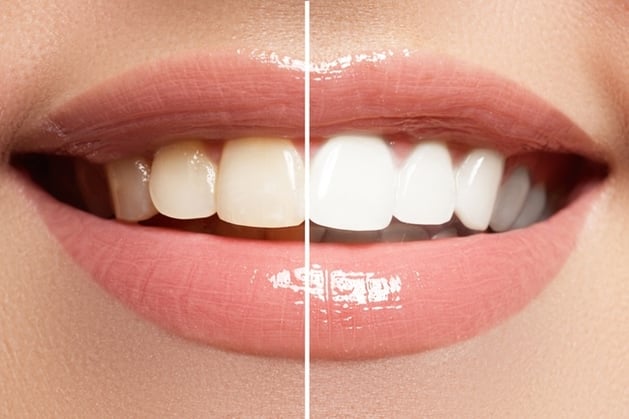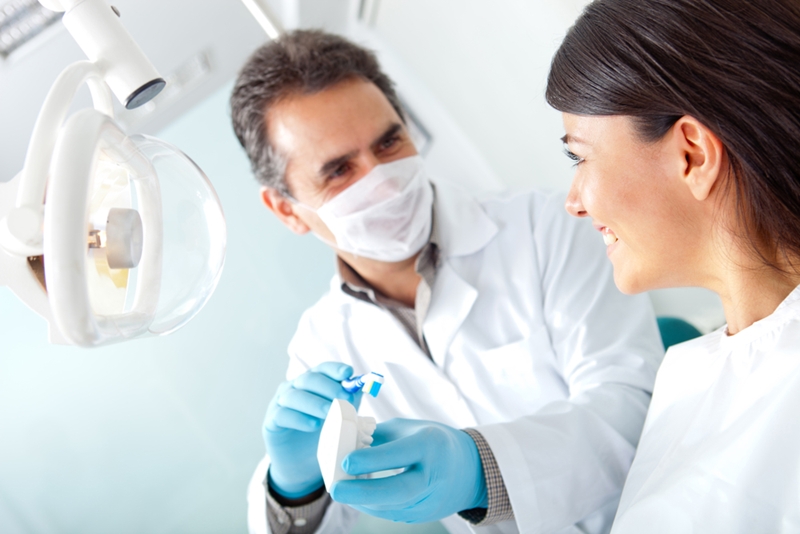
Yellow teeth are a common complaint among dental patients. While it's generally known that smoking cigarettes and drinking acidic beverages can stain teeth, people who practice poor dental habits aren't the only ones at risk. Even those who brush their teeth twice a day and floss once may experience a less-than-white smile. That's because the dentin, the inner layer of the tooth, naturally turns yellow over time.1 Additionally, certain medications necessary for one's overall well-being may also contribute to teeth yellowing.
Whether they're trying to get ready for a big day, such as a wedding, or just want a whiter smile in general, many people will opt for teeth-whitening treatments, both in and out of the dentist's office. Sometimes, whiter teeth can seem too good to be true. That is, many people wonder if the practice is safe and what the real results will be. Here's everything you need to know about teeth whitening:
"Teeth-whitening strips and gels change the color of the teeth."
Over-the-counter whitening products
The health and beauty aisles of stores are filled with teeth-whitening products. They are generally less expensive than in-office alternatives, but the process usually takes longer. Teeth-whitening strips and gels are over-the-counter bleaching agents that contain carbamide peroxide.2 Though they are applied differently, they work essentially the same way. These products change the color of the teeth by removing both extrinsic and intrinsic stains. All over-the-counter bleach whitening products are eligible for the American Dental Association (ADA) seal of approval. Products with this seal meet the ADA criteria by containing 10 percent carbamide peroxide.
The difference between the products? Whitening strips are thin, transparent coated with the whitening gel. They adhere to the teeth and are left on for a specific amount of time on a daily basis for a set number of days. Gel, on the other hand, is brushed directly on the teeth.
Whitening in your daily routine
Teeth-whitening doesn't necessarily have to branch outside your regular routine. Many products you use on a daily basis have whitening additives, including certain toothpastes and mouth rinses. However, these products can attack only surfaces stains and won't change the natural or intrinsic color of the tooth because they do not contain bleaching agents.
Toothpastes inherently whiten your teeth as they clean, but some are made to remove more than just daily bacteria. Toothpastes with extra whitening power typically contain abrasives that polish the teeth and chemicals that break down stains.3 Some of these toothpastes even contain blue covarine, a chemical that creates the optical illusion of whiter teeth.
In-office whitening
Your dentist can also perform a professional teeth whitening procedure on your mouth through in-office bleaching. Otherwise known as chairside bleaching, in-office teeth whitening treatments usually take only 30-60 minutes and can be completed in a single appointment. To do this, the dentist uses products with higher concentrations of hydrogen peroxide than those found in over-the-counter products. He or she may use bleaching agents, certain lighting, lasers or a combination of treatments.

You can receive professional teeth whitening with an in-office bleaching treatment.
Your dentist can also provide you with tray-based teeth whiteners as a supervised treatment method. He or she will give you a custom-made mold that fits to your teeth. These devices are either prefilled with whitening gel, or your dentist may give you gel with which to fill the tray yourself.4 Tray-based teeth whiteners must be worn for a specific period of time, which may vary from an hour to overnight depending on your oral care needs.
Remember, no teeth-whitening treatment is permanent. By avoiding stain-causing foods and drinks and practicing proper daily oral hygiene, you may be able to extend the time your teeth remain white. However, they will inevitably lose their brilliance and may need to be touched up with further treatments.
When to avoid teeth whitening
Many health professionals warn against whitening teeth if you have certain oral health conditions, including gum disease, worn enamel, allergies, exposed roots and tooth sensitivity. It's also not recommended if you're pregnant or nursing or have tooth-colored crowns and caps in the front of your teeth, which can't be bleached.
It's important to find a dentist and schedule an appointment if you're unsure if your mouth is healthy enough for whitening treatments. Of course, in-office whitening will require consultation with a dental health professional anyway, but you'll want to speak with a dentist even if you're using over-the-counter regimens. Additionally, be aware of the risks that come with do-it-yourself whitening treatments - that is, making gels and pastes from ingredients found in your kitchen. Though there are a lot of DIY options available on the Internet, it's important to talk to your dentist to evaluate whether the ingredients are safe to use and will actually whiten your teeth rather than cause more stains.
Make family dental a priority for everyone in your household. This way, you'll always have a trusted dental professional to whom you can direct questions about whitening or other oral conditions.
_______________________________________________________________________
1. "Tooth discoloration," Colgate. http://www.colgateprofessional.com/patient-education/articles/tooth-discoloration
2. "Statement on the Safety and Effectiveness of Tooth Whitening Products," American Dental Association, April 2012.
http://www.ada.org/en/about-the-ada/ada-positions-policies-and-statements/tooth-whitening-safety-and-effectiveness
3. "Does whitening toothpaste actually whiten teeth?" Alan Carr, D.M.D., Mayo Clinic.
http://www.mayoclinic.org/healthy-lifestyle/adult-health/expert-answers/whitening-toothpaste/faq-20058411
4. "Teeth whitening trays for a brighter smile," Crest. http://crest.com/en-us/oral-care-topics/whitening/teeth-whitening-trays
